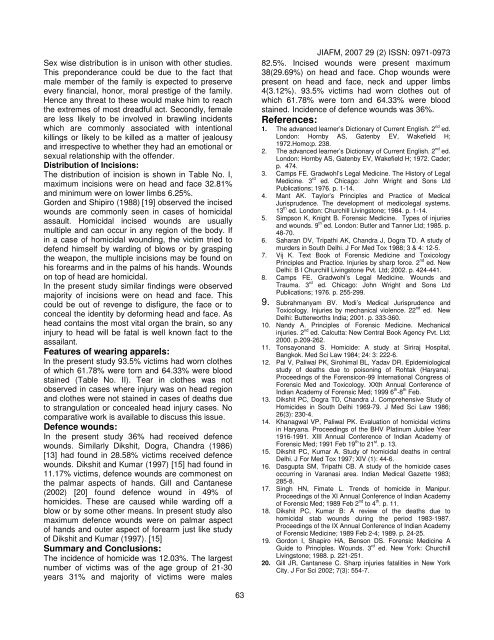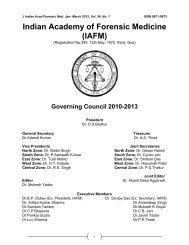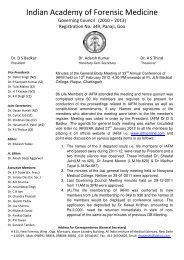Journal of Indian Academy of Forensic Medicine (JIAFM)
Journal of Indian Academy of Forensic Medicine (JIAFM)
Journal of Indian Academy of Forensic Medicine (JIAFM)
Create successful ePaper yourself
Turn your PDF publications into a flip-book with our unique Google optimized e-Paper software.
Sex wise distribution is in unison with other studies.<br />
This preponderance could be due to the fact that<br />
male member <strong>of</strong> the family is expected to preserve<br />
every financial, honor, moral prestige <strong>of</strong> the family.<br />
Hence any threat to these would make him to reach<br />
the extremes <strong>of</strong> most dreadful act. Secondly, female<br />
are less likely to be involved in brawling incidents<br />
which are commonly associated with intentional<br />
killings or likely to be killed as a matter <strong>of</strong> jealousy<br />
and irrespective to whether they had an emotional or<br />
sexual relationship with the <strong>of</strong>fender.<br />
Distribution <strong>of</strong> Incisions:<br />
The distribution <strong>of</strong> incision is shown in Table No. I,<br />
maximum incisions were on head and face 32.81%<br />
and minimum were on lower limbs 6.25%.<br />
Gorden and Shipiro (1988) [19] observed the incised<br />
wounds are commonly seen in cases <strong>of</strong> homicidal<br />
assault. Homicidal incised wounds are usually<br />
multiple and can occur in any region <strong>of</strong> the body. If<br />
in a case <strong>of</strong> homicidal wounding, the victim tried to<br />
defend himself by warding <strong>of</strong> blows or by grasping<br />
the weapon, the multiple incisions may be found on<br />
his forearms and in the palms <strong>of</strong> his hands. Wounds<br />
on top <strong>of</strong> head are homicidal.<br />
In the present study similar findings were observed<br />
majority <strong>of</strong> incisions were on head and face. This<br />
could be out <strong>of</strong> revenge to disfigure, the face or to<br />
conceal the identity by deforming head and face. As<br />
head contains the most vital organ the brain, so any<br />
injury to head will be fatal is well known fact to the<br />
assailant.<br />
Features <strong>of</strong> wearing apparels:<br />
In the present study 93.5% victims had worn clothes<br />
<strong>of</strong> which 61.78% were torn and 64.33% were blood<br />
stained (Table No. II). Tear in clothes was not<br />
observed in cases where injury was on head region<br />
and clothes were not stained in cases <strong>of</strong> deaths due<br />
to strangulation or concealed head injury cases. No<br />
comparative work is available to discuss this issue.<br />
Defence wounds:<br />
In the present study 36% had received defence<br />
wounds. Similarly Dikshit, Dogra, Chandra (1986)<br />
[13] had found in 28.58% victims received defence<br />
wounds. Dikshit and Kumar (1997) [15] had found in<br />
11.17% victims, defence wounds are commonest on<br />
the palmar aspects <strong>of</strong> hands. Gill and Cantanese<br />
(2002) [20] found defence wound in 49% <strong>of</strong><br />
homicides. These are caused while warding <strong>of</strong>f a<br />
blow or by some other means. In present study also<br />
maximum defence wounds were on palmar aspect<br />
<strong>of</strong> hands and outer aspect <strong>of</strong> forearm just like study<br />
<strong>of</strong> Dikshit and Kumar (1997). [15]<br />
Summary and Conclusions:<br />
The incidence <strong>of</strong> homicide was 12.03%. The largest<br />
number <strong>of</strong> victims was <strong>of</strong> the age group <strong>of</strong> 21-30<br />
years 31% and majority <strong>of</strong> victims were males<br />
63<br />
<strong>JIAFM</strong>, 2007 29 (2) ISSN: 0971-0973<br />
82.5%. Incised wounds were present maximum<br />
38(29.69%) on head and face. Chop wounds were<br />
present on head and face, neck and upper limbs<br />
4(3.12%). 93.5% victims had worn clothes out <strong>of</strong><br />
which 61.78% were torn and 64.33% were blood<br />
stained. Incidence <strong>of</strong> defence wounds was 36%.<br />
References:<br />
1. The advanced learner’s Dictionary <strong>of</strong> Current English. 2 nd ed.<br />
London: Hornby AS, Gatenby EV, Wakefield H;<br />
1972.Homo;p. 238.<br />
2. The advanced learner’s Dictionary <strong>of</strong> Current English. 2 nd ed.<br />
London: Hornby AS, Gatenby EV, Wakefield H; 1972. Cader;<br />
p. 474.<br />
3. Camps FE. Gradwohl’s Legal <strong>Medicine</strong>. The History <strong>of</strong> Legal<br />
<strong>Medicine</strong>. 3 rd ed. Chicago: John Wright and Sons Ltd<br />
Publications; 1976. p. 1-14.<br />
4. Mant AK. Taylor’s Principles and Practice <strong>of</strong> Medical<br />
Jurisprudence. The development <strong>of</strong> medicolegal systems.<br />
13 th ed. London: Churchill Livingstone; 1984. p. 1-14.<br />
5. Simpson K, Knight B. <strong>Forensic</strong> <strong>Medicine</strong>. Types <strong>of</strong> injuries<br />
and wounds. 9 th ed. London: Butler and Tanner Ltd; 1985. p.<br />
48-70.<br />
6. Saharan DV, Tripathi AK, Chandra J, Dogra TD. A study <strong>of</strong><br />
murders in South Delhi. J For Med Tox 1988; 3 & 4: 12-5.<br />
7. Vij K. Text Book <strong>of</strong> <strong>Forensic</strong> <strong>Medicine</strong> and Toxicology<br />
Principles and Practice. Injuries by sharp force. 2 nd ed. New<br />
Delhi: B I Churchill Livingstone Pvt. Ltd; 2002. p. 424-441.<br />
8. Camps FE. Gradwohl’s Legal <strong>Medicine</strong>. Wounds and<br />
Trauma. 3 rd ed. Chicago: John Wright and Sons Ltd<br />
Publications; 1976. p. 255-299.<br />
9. Subrahmanyam BV. Modi’s Medical Jurisprudence and<br />
Toxicology. Injuries by mechanical violence. 22 nd ed. New<br />
Delhi: Butterworths India; 2001. p. 333-360.<br />
10. Nandy A. Principles <strong>of</strong> <strong>Forensic</strong> <strong>Medicine</strong>. Mechanical<br />
injuries. 2 nd ed. Calcutta: New Central Book Agency Pvt. Ltd;<br />
2000. p.209-262.<br />
11. Tonsayonand S. Homicide: A study at Siriraj Hospital,<br />
Bangkok. Med Sci Law 1984; 24: 3: 222-6.<br />
12. Pal V, Paliwal PK, Sirohimal BL, Yadav DR. Epidemiological<br />
study <strong>of</strong> deaths due to poisoning <strong>of</strong> Rohtak (Haryana).<br />
Proceedings <strong>of</strong> the <strong>Forensic</strong>on-99 International Congress <strong>of</strong><br />
<strong>Forensic</strong> Med and Toxicology. XXth Annual Conference <strong>of</strong><br />
<strong>Indian</strong> <strong>Academy</strong> <strong>of</strong> <strong>Forensic</strong> Med; 1999 6 th -8 th Feb.<br />
13. Dikshit PC, Dogra TD, Chandra J. Comprehensive Study <strong>of</strong><br />
Homicides in South Delhi 1969-79. J Med Sci Law 1986;<br />
26(3): 230-4.<br />
14. Khanagwal VP, Paliwal PK. Evaluation <strong>of</strong> homicidal victims<br />
in Haryana. Proceedings <strong>of</strong> the BHV Platinum Jubilee Year<br />
1916-1991. XIII Annual Conference <strong>of</strong> <strong>Indian</strong> <strong>Academy</strong> <strong>of</strong><br />
<strong>Forensic</strong> Med; 1991 Feb 19 th to 21 st . p. 13.<br />
15. Dikshit PC, Kumar A. Study <strong>of</strong> homicidal deaths in central<br />
Delhi. J For Med Tox 1997; XIV (1): 44-6.<br />
16. Dasgupta SM, Tripathi CB. A study <strong>of</strong> the homicide cases<br />
occurring in Varanasi area. <strong>Indian</strong> Medical Gazette 1983;<br />
285-8.<br />
17. Singh HN, Fimate L. Trends <strong>of</strong> homicide in Manipur.<br />
Proceedings <strong>of</strong> the XI Annual Conference <strong>of</strong> <strong>Indian</strong> <strong>Academy</strong><br />
<strong>of</strong> <strong>Forensic</strong> Med; 1989 Feb 2 nd to 4 th . p. 11.<br />
18. Dikshit PC, Kumar B: A review <strong>of</strong> the deaths due to<br />
homicidal stab wounds during the period 1983-1987.<br />
Proceedings <strong>of</strong> the IX Annual Conference <strong>of</strong> <strong>Indian</strong> <strong>Academy</strong><br />
<strong>of</strong> <strong>Forensic</strong> <strong>Medicine</strong>; 1989 Feb 2-4; 1989. p. 24-25.<br />
19. Gordon I, Shapiro HA, Benson DS. <strong>Forensic</strong> <strong>Medicine</strong> A<br />
Guide to Principles. Wounds. 3 rd ed. New York: Churchill<br />
Livingstone; 1988. p. 221-251.<br />
20. Gill JR, Cantanese C. Sharp injuries fatalities in New York<br />
City. J For Sci 2002; 7(3): 554-7.









